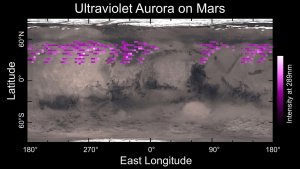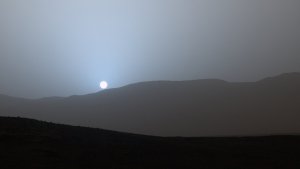Space

MAVEN spacecraft detected evidence of widespread auroras in Mars's northern hemisphere. The "Christmas Lights," as researchers called them, circled the globe and descended so close to the Martian equator that, if the lights had occurred on Earth, they would have been over places like Florida and Texas. »

NASA's Curiosity Mars rover recorded this view of the sun setting at the close of the mission's 956th Martian day, or sol, from the rover's location in Gale Crater. »
New research using data from NASA's Cassini mission suggests most of the eruptions from Saturn's moon Enceladus might be diffuse curtains rather than discrete jets. Many features that appear to be individual jets of material erupting along the length of prominent fractures in the moon's south polar region might be phantoms created by an optical illusion, according to the new study. »

Four men trapped under as much as 10 feet of bricks, mud and other debris have been rescued in Nepal thanks to a new search-and-rescue technology developed in partnership by DHS, S&T and NASA/JPL. »
A NASA planetary exploration mission came to a planned, but nonetheless dramatic, end Thursday when it slammed into Mercury’s surface at about 8,750 mph and created a new crater on the planet’s surface. »
After extraordinary science findings and technological innovations, a NASA spacecraft launched in 2004 to study Mercury will impact the planet’s surface, most likely on April 30, after it runs out of propellant. »
Long, sinuous, tendril-like structures seen in the vicinity of Saturn's icy moon Enceladus originate directly from geysers erupting from its surface, according to scientists studying images from NASA's Cassini spacecraft. »
Martian weather and soil conditions that NASA's Curiosity rover has measured, together with a type of salt found in Martian soil, could put liquid brine in the soil at night. »
The long-standing mystery of why Saturn seethes with enormous storms every 30 years may have been solved by scientists. The tempests, which can grow into bright bands that encircle the entire planet, are on a natural timer that is reset by each subsequent storm. »
Two-tone mineral veins at a site NASA's Curiosity rover has reached by climbing a layered Martian mountain offer clues about multiple episodes of fluid movement. These episodes occurred later than the wet environmental conditions that formed lake-bed deposits the rover examined at the mountain's base. »
A dual view of Saturn's icy moon Rhea marks the return of NASA's Cassini spacecraft to the realm of the planet's icy satellites. This follows nearly two years during which the spacecraft's orbits carried it high above the planet's poles. Those paths limited the mission's ability to encounter the moons, apart from regular flybys of Titan. »
A team using the Sample Analysis at Mars (SAM) instrument suite aboard NASA's Curiosity rover has made the first detection of nitrogen on the surface of Mars from release during heating of Martian sediments. »
Mars Exploration Rover Opportunity completed its first Red Planet distance on March 24, 2015 - 42.195 kilometers - with a finish time of roughly 11 years and two months. »
Using Stratospheric Observatory for Infrared Astronomy, an international scientific team discovered that supernovae are capable of producing a substantial amount of the material from which planets like Earth can form. »
Hubble Space Telescope has the best evidence yet for an underground saltwater ocean on Ganymede, Jupiter’s largest moon. The subterranean ocean is thought to have more water than all the water on Earth's surface. »
Cassini spacecraft has provided scientists the first clear evidence that Saturn's moon Enceladus exhibits signs of present-day hydrothermal activity which may resemble that seen in the deep oceans on Earth. The implications of such activity on a world other than our planet open up unprecedented scientific possibilities. »
Astronomers using data from NASA's Wide-field Infrared Survey Explorer, or WISE, have found a cluster of stars forming at the very edge of our Milky Way galaxy. »
The Beagle 2 Mars Lander, built by the United Kingdom, has been thought lost on Mars since 2003, but has now been found in images from NASA's Mars Reconnaissance Orbiter. »
Astronomers have observed the largest X-ray flare ever detected from the supermassive black hole at the center of the Milky Way galaxy. This event, detected by NASA’s Chandra X-ray Observatory, raises questions about the behavior of this giant black hole and its surrounding environment. »
Dawn spacecraft has entered an approach phase in which it will continue to close in on Ceres, a Texas-sized dwarf planet never before visited by a spacecraft. Dawn launched in 2007 and is scheduled to enter Ceres orbit in March 2015. »
NASA and an international team of planetary scientists have found evidence in meteorites on Earth that indicates Mars has a distinct and global reservoir of water or ice near its surface. »
Mars Curiosity rover has measured a tenfold spike in methane, an organic chemical, in the atmosphere around it and detected other organic molecules in a rock-powder sample collected by the robotic laboratory’s drill. »
Long ago, in the largest canyon system in our solar system, vibrations from "marsquakes" shook soft sediments that had accumulated in Martian lakes. »
Scientists have produced a new version of what is perhaps NASA's best view of Jupiter's ice-covered moon, Europa. The mosaic of color images was obtained in the late 1990s by NASA's Galileo spacecraft. This is the first time that NASA is publishing a version of the scene produced using modern image processing techniques. »
Two NASA and one European spacecraft that obtained the first up-close observations of a comet flyby of Mars on Oct. 19, have gathered new information about the basic properties of the comet's nucleus and directly detected the effects on the Martian atmosphere. »
A planet may be causing the star it orbits to act much older than it actually is, according to new data from NASA’s Chandra X-ray Observatory. This discovery shows how a massive planet can affect the behavior of its parent star. »
NASA scientists have identified an unexpected high-altitude methane ice cloud on Saturn's moon Titan that is similar to exotic clouds found far above Earth's poles. »
A new study focused on the interior of Saturn's icy moon Mimas suggests its cratered surface hides one of two intriguing possibilities: Either the moon's frozen core is shaped something like a football, or the satellite contains a liquid water ocean. »
Mars Atmosphere and Volatile Evolution (MAVEN) spacecraft successfully entered Mars' orbit at 7:24 p.m. PDT Sunday, Sept. 21, where it now will prepare to study the Red Planet's upper atmosphere as never done before. MAVEN is the first spacecraft dedicated to exploring the tenuous upper atmosphere of Mars. »
Astronomers have for the first time caught a glimpse of the earliest stages of massive galaxy construction. The building site, dubbed "Sparky," is a dense galactic core blazing with the light of millions of newborn stars that are forming at a ferocious rate. »
NASA's Pluto-bound New Horizons spacecraft has traversed the orbit of Neptune. This is its last major crossing en route to becoming the first probe to make a close encounter with distant Pluto on July 14, 2015. »
NASA's Spitzer Space Telescope has spotted an eruption of dust around a young star, possibly the result of a smashup between large asteroids. This type of collision can eventually lead to the formation of planets. »
Voyager 2 spacecraft gave humanity its first close-up look at Neptune and its moon Triton in the summer of 1989. Like an old film, Voyager's historic footage of Triton has been "restored" and used to construct the best-ever global color map of that strange moon. »
Cassini spacecraft recently captured images of clouds moving across the northern hydrocarbon seas of Saturn's moon Titan. This renewed weather activity, considered overdue by researchers, could finally signal the onset of summer storms that atmospheric models have long predicted. »
Three massive volcanic eruptions occurred on Jupiter's moon Io within a two-week period in August of last year. This led astronomers to speculate that such "outbursts," which can send material hundreds of miles above the surface, might be much more common than they thought. »